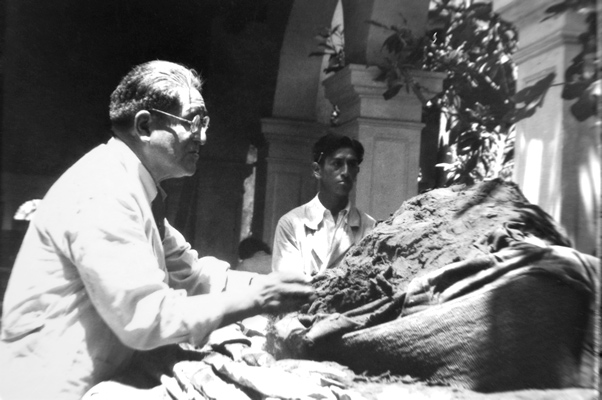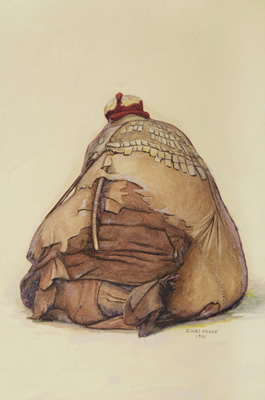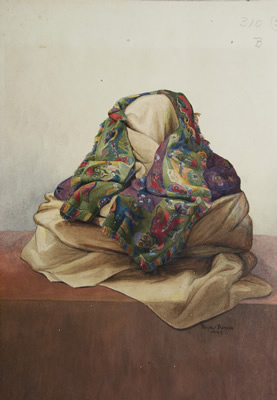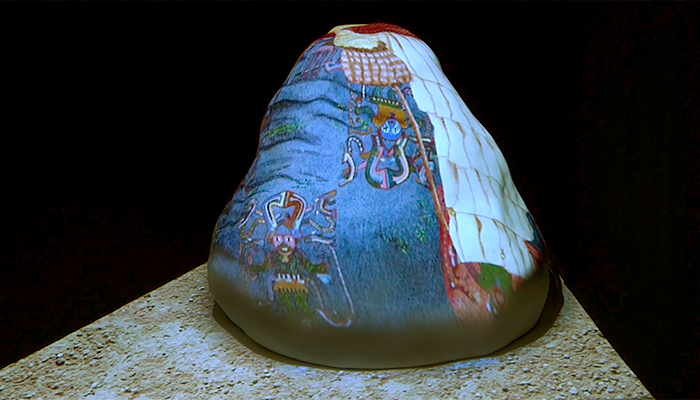Paracas Funerary Mantles: Offerings for Life – 2015
- Paracas funerary mantles: Offerings for Life
- Who Were The Paracas?
- The Wari Kayán Cemetery and Its discoverer
- What is a funerary bundle?
- Offerings for the Afterlife
- “Reading” the Images
- Severed heads, trophy heads
- Paracas textile art
- Three styles of embroidery
- A miniature outfit
- Headband: Turban I
- Headband: Turban II
- Headband: Turban III
- Turban-cloth: Two-headed serpents
- Skirt: Big-Eyed Being
- Uncu tunic with felines: Big-eyed Being
- Short poncho: Orcas
- Short poncho: Feline-Man
- Short poncho with fringes: Big-Eyed Being
- Attire of a Paracas chief
- Opening a funerary bundle from the Wari Kayán Necrópolis
- Mantles for the afterfile
- Bibliographic references
- Credits
Opening a funerary bundle from the Wari Kayán Necrópolis
These six watercolors by Peruvian painter Pedro Rojas Ponce (1941) portray some of the stages in which Julio C. Tello unwrapped a funerary bundle at the Museo Nacional de Arqueología de Lima in 1933. The paintings refer to Mummy Nº 310, 1.60 meters high, with 92 different objects as funerary offerings. The bundle belongs to a male individual and is considered “first class” for the wealth of textiles it contained, two of which are displayed in this exhibition (funerary mantle RT-1532 and short poncho RT-1807).





































![“[…] under the deer hide is a layer of six embroidered mantles...a fine embroidered mantle of blue wool…with trapezoidal fringes.”
Stage one. Watercolor, Pedro Rojas Ponce, 1941. 47, 5 x 36 cm (INC/MNAAHP, Inv. AT-1097)](https://precolombino.cl/wp/wp-content/uploads/2015/12/9.1.-Acuarela-Fardo-1-Fase2.jpg)


![“[…] with this cloth removed, two embroidered mantles appear: one of blue wool with figures of two-headed worms [in this exhibition] and another of yellow wool with green stripes with human-like figures.”
Stage four. Watercolor, Pedro Rojas Ponce, 1941. 47, 5 x 36 cm (INC/MNAAHP, Inv. AT-1098)](https://precolombino.cl/wp/wp-content/uploads/2015/12/9.4.-Acuarela-Fardo-4-Fase2.jpg)
![“[…] the cloth of the first wrapping was removed…and the mummy is seen positioned inside a basket and wrapped in a blue cotton cloth…”
Stage five. Watercolor, Pedro Rojas Ponce, 1941. 47, 5 x 36 cm (INC/MNAAHP, Inv. AT-1099)](https://precolombino.cl/wp/wp-content/uploads/2015/12/9.5.-Acuarela-Fardo-5-Fase3.jpg)
![“[…] underneath there appears the shroud of the cadaver…in a sitting position with knees pulled upward…there is yellowish yarn on the seat, the body is wrapped in cotton cloths tied at the back…”
Stage six. Watercolor, Pedro Rojas Ponce, 1941. 47, 5 x 36 cm (INC/MNAAHP, Inv. AT-1100)](https://precolombino.cl/wp/wp-content/uploads/2015/12/9.6.-Acuarela-Fardo-6-Fase2.jpg)
